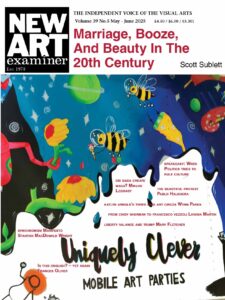
Each issue, the New Art Examiner will invite a well-known, or not so well-known, art world personality to write a speakeasy essay on a topic of interest.
LIVIANA MARTIN was born in Northern Italy and lives in Milan. She has a degree in philosophy and she taught for many years. She is keen on ancient and contemporary art, because she is absolutely confident that “the beauty will save the world”.
“You were not made to live like brutes, but to follow virtue and knowledge.”
The words that Ulysses, in the Divine Comedy, addresses to his companions challenging them to go beyond the Pillars of Hercules, beyond the known world, accompany my reflections on the Italian cultural heritage and the art market.
 A few days ago, an article in the newspaper Corriere della Sera reported the news that the mayor of Venice had ordered the closure of all civic museums, explaining that due to the pandemic, there were no more tourists in the city. Obviously, the valuable works exhibited do not belong to all citizens, but are a disposable enticement to visitors, to be consumed together with a drink and sandwich. Certainly, on city tours, visits to art institutions are generally hasty, an excuse to take a few selfies more than to gain knowledge of the artists and the context in which the work was made. But if we move to top exhibitions, things don’t always get any better. As art historians such as Tomaso Montanari or Salvatore Settis point out, more and more often it is not museums that promote artistic events, but private companies that care more about marketing than artistic competence. Before the pandemic in Milan there were exhibitions that were not memorable but, thanks to clever advertising, attracted endless lines of customers. That is precisely what the consumers of these exhibitions are called by most critics. An exhibition should be curated to encourage the cultural enrichment of the spectators, promoting in them a desire for a profound, not just passive, experience. A personal example – some time ago, I very much enjoyed an exhibition on Bernardino Luini, a 16th-century Milanese artist who had also worked in many Lombard churches. I discovered his canvases and his frescoes, present in Milanese churches that I had never visited before, in front of which I had passed countless times without ever entering.
A few days ago, an article in the newspaper Corriere della Sera reported the news that the mayor of Venice had ordered the closure of all civic museums, explaining that due to the pandemic, there were no more tourists in the city. Obviously, the valuable works exhibited do not belong to all citizens, but are a disposable enticement to visitors, to be consumed together with a drink and sandwich. Certainly, on city tours, visits to art institutions are generally hasty, an excuse to take a few selfies more than to gain knowledge of the artists and the context in which the work was made. But if we move to top exhibitions, things don’t always get any better. As art historians such as Tomaso Montanari or Salvatore Settis point out, more and more often it is not museums that promote artistic events, but private companies that care more about marketing than artistic competence. Before the pandemic in Milan there were exhibitions that were not memorable but, thanks to clever advertising, attracted endless lines of customers. That is precisely what the consumers of these exhibitions are called by most critics. An exhibition should be curated to encourage the cultural enrichment of the spectators, promoting in them a desire for a profound, not just passive, experience. A personal example – some time ago, I very much enjoyed an exhibition on Bernardino Luini, a 16th-century Milanese artist who had also worked in many Lombard churches. I discovered his canvases and his frescoes, present in Milanese churches that I had never visited before, in front of which I had passed countless times without ever entering.
Exhibitions should be the result of research or some discovery that justifies their organization. And the strong reason that led to their realization should be clear. Instead, the exhibits are often blockbusters, a triumph of quantity over quality, or 3D experiences, where the emotions of the viewer, not their intellect, are involved, nothing more.
During a conference in Bilbao in 2011, Umberto Eco provocatively launched the idea of a monographic museum, centered on a single masterpiece, to document the different aspects, the relations of the society in which it was created (the historical/artistic/cultural references, and so on). He titled it ‘The Museum of the Third Millennium’. It would be a great challenge to create something so radical and at the same time didactically useful. How many times have I left a museum after having seen hundreds of works, without remembering what I had seen, such was the curated confusion. One should, and many probably do, enter museums several times, to slowly savour only a few works. On the other hand, when we go to the library, we don’t want to read all the books, but only what interests us.
Italy is rich in cultural heritage, protected by the Constitution: Article 9 states that “The Republic protects the landscape and the historical and artistic heritage of the nation”. The tradition of protecting the artistic and environmental heritage in Italy goes back a long way and was advanced for the time when the Constitution was written in 1948.
In England, up until the 1970s, more than 1000 country houses were demolished by their owners to make them more modern. This is because the owners were free to do what they wanted without state control, while in Italy it would not have been possible. More: if while digging in my garden I find an antique artifact, which is very common in certain Italian areas, I must notify the superintendency because the statue is public property (this of course in theory, because theft of works of art is frequent). In the US, however, if I find the remains of an Indian village while digging, I can eliminate them to build a swimming pool. In fact the beautiful American art museums do not generally relate to the cities that host them; they arose, for the most part, from art collections by European artists, primarily the French Impressionists. In Italy, on the other hand, the model of the museum is to be rooted in the territory and its history, so as to create an uninterrupted link between the inside and the outside, between the objects on display and the cultural and civic fabric of the territory in which they originated.
If these are the lights of how Italian cultural heritage has been managed, many shadows over the last few years have thickened on what has been unhappily defined as Italy’s petroleum, or rather our artistic heritage. The definition allows some art to be exploited and sold, or in some cases undersold.
First of all, we are witnessing the sale of entire buildings in many Italian cities, especially in Venice, which is an emblematic case study. The Prada Foundation for fashion has bought a magnificent palace on the Grand Canal, Benetton (fashion) has rearranged the antique warehouse Fondaco dei Tedeschi, making it a temple of luxury, and the French magnate Pinault has transformed the Salt warehouses at the tip of the Customs House into a contemporary art gallery where his collections often are shown. Of course the renovation is magnificent, the architects called to do it respected the building structures without distorting their characteristics. But one wonders whether it is right to privatize public assets, which belong to all citizens?
And it could have been worse: in 2012 the designer Pierre Cardin (of Venetian origins) wanted to build a 250-meter tower in the Venetian hinterland, the ‘Palais Lumière’, which would have turned the Venetian skyline upside down. While the local authorities, the mayor among them, gave their permission, the project fortunately did not go through due to credit problems with the banks.
Another serious problem is the state of many public buildings: due to the neglect of the institutions, sinkholes open up in churches, as happened in Naples, while humidity, theft and vandalism ruin wonderful sites which should be protected as cultural assets.
The problem, in addition to a widespread cultural lack of interest, is the allocation of funds for conservation and restoration. In the three-year period 2012-2014, €1.5 billion was allocated for the management of cultural heritage, €25 billion for weapons, and €40 billion for the rescue of banks. Spending on culture amounts to 1.1% of public expenditure, while in France it reaches 2.5% and in Spain 3.3%.
I do not know if in the future this short-sighted attitude of our governments will change, given that during the pandemic the first to close were museums, theatres and schools, which are still closed, while all kinds of shops remain open. Does that not say it all?
Volume 35 no 5 May / June 2021

